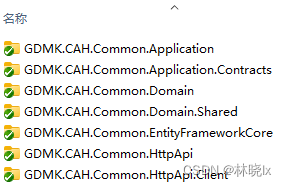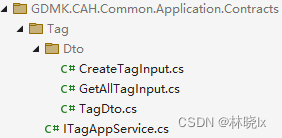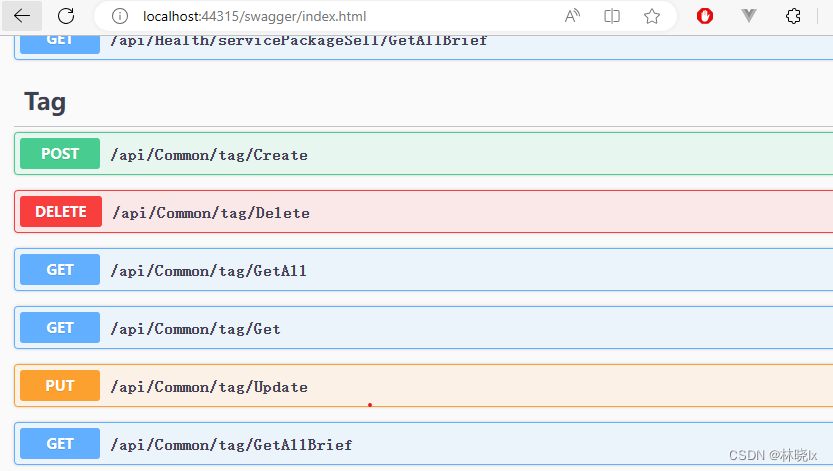Volo.Abp升級小記(二)建立全新微服務模組
@
假設有一個按照官方sample搭建的微服務專案,並安裝好了abp-cli。
需要建立一個名為GDMK.CAH.Common的模組,並在模組中建立標籤管理功能
因為大部分的程式碼是自動生成的,此範例僅描述需要手動更改的內容。我們以建立一個全新的最小化的微服務模組為例,需要做以下幾步:
建立模組
用abp-cli建立一個新的模組
在專案根目錄下執行以下命令:
abp new GDMK.CAH.Common --template module --no-ui --ui='none' -d='ef' --output-folder .\modules\GDMK.CAH.Common --local-framework-ref --abp-path ..\..\..\..\abp\
--template module: 模組/服務模板
--no-ui: 不建立前端專案
-d: 指定資料庫提供程式為ef.
--output-folder: 指定輸出目錄
--local-framework-ref: 使用本地abp框架
你可以自由設定模板選項,詳情請參考abp-cli檔案
我們只需要保留應用層,領域層,資料庫,Api存取層以及各抽象層。將這些專案放在模組目錄下,即當前位置(.\modules\GDMK.CAH.Common)
Common.Host專案作為微服務單獨放置在服務目錄中(一般為microservices)
看起來模組的目錄結構如下

領域層
領域層中我們建立一個Tag實體、領域層服務和模型
Tag實體
public class Tag : AuditedEntity<long>, IMultiTenant
{
...
}
Tag領域層服務
public class TagManager<T> : DomainService
{
...
}
頁面結構看起來像這樣

應用層
在應用層抽象層中建立ITagAppService介面,以及各Dto類。
ITagAppService介面繼承ICurdAppService,實現標籤管理的增刪改查功能
public interface ITagAppService : ICurdAppService<TagDto, TagDto, long, GetAllTagInput, GetAllTagInput, CreateTagInput, CreateTagInput>, IApplicationService
{
...
}
頁面結構看起來像這樣

應用層中建立標籤管理的應用層服務TagAppService
TagAppService繼承CurdAppServiceBase,實現ITagAppService介面
public class TagAppService : CurdAppServiceBase<Tag, TagDto, TagDto, long, GetAllTagInput, GetAllTagInput, CreateTagInput, CreateTagInput>, ITagAppService
{
...
}

設定AutoMapper
在CommonApplicationAutoMapperProfile中新增Tag的對映設定
public class CommonApplicationAutoMapperProfile : Profile
{
public CommonApplicationAutoMapperProfile()
{
/* You can configure your AutoMapper mapping configuration here.
* Alternatively, you can split your mapping configurations
* into multiple profile classes for a better organization. */
CreateMap<Tag.Tag, TagDto>();
CreateMap<TagDto, Tag.Tag>().Ignore(c => c.TenantId);
CreateMap<CreateTagInput, Tag.Tag>().IgnoreAuditedObjectProperties()
.Ignore(c => c.TenantId);
}
}
資料庫和倉儲
在CommonDbContext中新增Tag的DbSet
public class CommonDbContext : AbpDbContext<CommonDbContext>, ICommonDbContext
{
/* Add DbSet for each Aggregate Root here. Example:
* public DbSet<Question> Questions { get; set; }
*/
public DbSet<Tag.Tag> Tag { get; set; }
...
}
在CommonDbContextModelCreatingExtensions中新增對Tag實體的設定
ConfigureByConvention會根據DataAnnotationAttributes為實體設定一些預設的屬性,如Id為主鍵,Name為索引等,詳情請參考Abp檔案和EF檔案
public static class CommonDbContextModelCreatingExtensions
{
public static void ConfigureCommon(
this ModelBuilder builder)
{
Check.NotNull(builder, nameof(builder));
builder.Entity<Tag.Tag>(b =>
{
b.ToTable(CommonDbProperties.DbTablePrefix + nameof(Tag.Tag), CommonDbProperties.DbSchema);
b.ConfigureByConvention();
});
...
}
}
在CommonEntityFrameworkCoreModule的ConfigureServices方法中,為Tag新增預設倉儲
public class CommonEntityFrameworkCoreModule : AbpModule
{
public override void ConfigureServices(ServiceConfigurationContext context)
{
context.Services.AddAbpDbContext<CommonDbContext>(options =>
{
/* Add custom repositories here. Example:
* options.AddRepository<Question, EfCoreQuestionRepository>();
*/
options.AddDefaultRepositories(includeAllEntities: true);
});
}
}
控制器
新增控制器,設定路由

[Area(CommonRemoteServiceConsts.ModuleName)]
[RemoteService(Name = CommonRemoteServiceConsts.RemoteServiceName)]
[Route("api/Common/tag")]
public class TagController : CommonController<ITagAppService, TagDto, TagDto, long, GetAllTagInput, GetAllTagInput, CreateTagInput, CreateTagInput>, ITagAppService
{
private readonly ITagAppService _tagAppService;
public TagController(ITagAppService tagAppService) : base(tagAppService)
{
_tagAppService = tagAppService;
}
}
設定微服務
在服務目錄中開啟Common.Host專案,將CommonHttpApi,CommonApplication以及CommonEntityFrameworkCore模組新增到專案參照,並建立Abp模組的依賴關係
[DependsOn(
typeof(AbpAutofacModule),
typeof(AbpAspNetCoreMvcModule),
typeof(AbpEntityFrameworkCoreSqlServerModule),
typeof(CommonHttpApiModule),
typeof(CommonApplicationModule),
typeof(CommonEntityFrameworkCoreModule),
...
)]
public class CommonServiceHostModule : AbpModule
在launchSettings.json中指定埠號,此埠號不要跟其他服務的埠號衝突
"profiles": {
"CommonService.Host": {
"commandName": "Project",
"launchBrowser": true,
"applicationUrl": "http://localhost:44363",
"environmentVariables": {
"ASPNETCORE_ENVIRONMENT": "Development"
}
}
...
}
準備一些種子資料
public static List<Tag> tags = new List<Tag>()
{
new Tag() { Title = "醫術高明" },
new Tag() { Title = "救死扶傷" },
new Tag() { Title = "心地仁慈" },
new Tag() { Title = "百治百效" },
new Tag() { Title = "白衣天使" },
new Tag() { Title = "手到病除" },
new Tag() { Title = "妙手回春" },
};
在CommonServiceDataSeeder建立種子資料
public class CommonServiceDataSeeder : IDataSeedContributor, ITransientDependency
{
private readonly IRepository<Tag.Tag, long> _tagRepository;
public CommonServiceDataSeeder(
IRepository<Tag.Tag, long> tagRepository)
{
_tagRepository = tagRepository;
}
[UnitOfWork]
public virtual async Task SeedAsync(DataSeedContext context)
{
await _tagRepository.InsertManyAsync(StaticMember.tags);
}
}
建立遷移
將Common.Host設定為啟動專案,開啟程式包管理器控制檯選擇Common.Host預設專案。
執行Add-Migration init命令和Update-Database命令

測試微服務
啟動Common.Host,開啟瀏覽器,輸入http://localhost:44363/swagger/index.html

微服務註冊
新增資源設定
AuthServerDataSeeder中新增identityServer4資源設定
新增Scopes
private async Task CreateApiScopesAsync()
{
...
await CreateApiScopeAsync("CommonService");
}
新增Resource
private async Task CreateApiResourcesAsync()
{
...
await CreateApiResourceAsync("CommonService", commonApiUserClaims);
}
新增Client
private async Task CreateClientsAsync()
{
...
await CreateClientAsync(
"common-service-client",
commonScopes.Union(new[] { "InternalGateway", "IdentityService" }),
new[] { "client_credentials" },
commonSecret
);
}
設定閘道器
在內外閘道器的appsettings.json中新增Ocelot對微服務的路由轉發
{
"DownstreamPathTemplate": "/api/common/{everything}",
"DownstreamScheme": "http",
"DownstreamHostAndPorts": [
{
"Host": "localhost",
"Port": 44363
}
],
"UpstreamPathTemplate": "/api/common/{everything}",
"UpstreamHttpMethod": [ "Put", "Delete", "Get", "Post" ]
}
閘道器中新增對CommonHttpApi專案的參照,並設定Abp模組依賴
namespace BackendAdminAppGateway.Host
{
[DependsOn(
...
typeof(CommonHttpApiModule)
)]
public class BackendAdminAppGatewayHostModule : AbpModule
...
選擇啟動專案,將Common.Host微服務設定為啟動

到此完成了新模組的設定工作
執行專案
可以通過閘道器存取Tag介面了

本文來自部落格園,作者:林曉lx,轉載請註明原文連結:https://www.cnblogs.com/jevonsflash/p/17469191.html